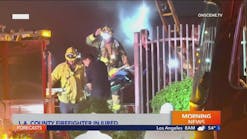Why, in this day and age, would calling a Mayday be anything other than an action supported by everyone in the fire service? Dr. Burton Clark of the National Fire Academy, father of the modern Mayday program, points out that is not the case in other disciplines that deal with life and death. According to Clark, a U.S. Air Force pilot is chastised and disciplined for trying to save his $70 million plane (even if he is successful) as opposed to ejecting, based on certain parameters detailed in standard operating procedures (SOPs). The point being, the Air Force expects certain reactions to an anticipated event, regardless of the outcome. Why don't we?
After participating in Mayday training at fire service conferences, the problem became clear. Calling a Mayday is largely misunderstood. The history and culture of the fire service overshadows the value of learning to call a Mayday, and more importantly encouraging that behavior.
According to some the fire service can be traced back to the ancient Rome, where slaves would be positioned around the city to sound an alarm for residents in the event a fire was spotted. Since they were slaves, you can imagine the level and timeliness of the service. After one particularly disastrous fire, the slaves were replaced with free men. The free men were organized like the Roman Army with a chain of command and performed inspections as well as suppression activities. The rest is history.
With such a long history and deeply entrenched tradition, it is no wonder that calling a Mayday is viewed by some as a sign of weakness and even failure. Chief Alan Brunacini once said, "The hardest thing to do is to put a fireman in reverse." Calling a Mayday requires that the firefighter stop, evaluate his or her circumstances, and then call for help. Not help to rescue victims or advance a hoseline, but help to assist because a facemask strap is caught on a nail.
The problem also lies with our basic training. Currently, new firefighters are not taught "Mayday." The National Fire Protection Association (NFPA) 1001 standard, Firefighter Professional Qualifications, does not address or teach "Mayday." Even worse, NFPA 1500 writes, "the term Mayday should not be used for fireground communications on that it could cause confusion with the term used for aeronautical and nautical emergencies." Ask any brand-new firefighter in your station if they were given Mayday training. The answer will probably surprise you.
The solution rests in changing the culture of the fire service, individual stations and departments. Culture is defined as the totality of socially transmitted behavior patterns, arts, beliefs, institutions, and all other products of human work and thought typical of a population or community at a given time. Change in culture requires that there be a change in behavior patterns. Changing a behavior pattern is nothing more than repeating the new behavior until it becomes a pattern; we call this training. Since we are fortunate that Maydays are not called regularly, the best way to change is repeated training.
Two years ago, the chief of the Huntingtown, MD, Volunteer Fire Department felt so strongly that the Mayday program could save lives that he made the training mandatory - the ability to ride fire equipment was based on successful completion of the Mayday program. This represented a significant change in the department. Before this decision, CPR and formal training provided by the University of Maryland was all that was needed to ride as a firefighter.
The program closely follows the Federal Emergency Management Agency (FEMA) program developed by Dr. Clark. Additionally, they review National Institute for Occupational Safety and Health (NIOSH) firefighter line-of-duty-death reports to see whether the outcome might have been different had a Mayday been called. Participants do not second guess; rather, they try to learn from these tragedies to avoid repeating them.
Dr. Clark teaches the following Mayday parameters:
- Fall
- Collapse
- Activated PASS or low-air alarm
- Caught/tangled/pinned/stuck/trapped
- Lost/disoriented Dr. Clark also teaches LUNAR, which stands for:
- Location (basement, attic, first floor, outside, quadrant, etc.)
- Unit (engine, squad, truck, etc.)
- Name
- Assignment (nozzle, backup, search and rescue, etc.)
- Resources needed (cutting tools, saw, lifting equipment, etc.)
Here's an example of a Mayday transmission:
"Mayday, Mayday, Mayday. This is Firefighter Borden assigned to Engine 62. I followed the hoseline into the building on the 1st floor. I'm trapped in a room in Quadrant C and will need cutting tools to be removed." He would then wait for an acknowledgement, activate his PASS device and Emergency Identifier (EI) button if possible.
During the Mayday training, a firefighter wearing a covered facepiece follows a hoseline (photo 1). Two firefighters drop a section of chain link fence onto the firefighter to simulate a collapse (photo 2). The firefighter must be able to call a Mayday and relay the LUNAR. Once an acknowledgement is received, the chain link fence is removed and the firefighter continues (photo 3). Next, a wire snare is placed around the entire SCBA bottle and harness. The firefighter, realizing he is caught, will declare a Mayday. At the third station, the firefighter continues to follow the hoseline and enters a room where either the door is chocked shut and becomes lost or becomes disoriented due to several different hoselines (photo 4). A Mayday is declared, and the firefighter continues. Finally, the firefighter comes to a set of stairs. At the top stair is a hinged board supported by wooden dowels (photo 5). The weight of the firefighter breaks the dowels, causing the firefighter to fall into soft material such as foam, mattresses or sponges (photo 6). An additional station is designated for the final skill: A firefighter with a covered facepiece must be able to disconnect his self-contained breathing apparatus (SCBA) buddy-breathing hose and hook into a "downed firefighter" (photo 7).
Developing a Mayday program for your station is inexpensive, easy to make and can be portable. For example, a simple prop can be built using plywood. Simply build an eight-by-four-foot ramp (one sheet of plywood) four feet high. Attach it to a reinforced box eight feet long and four feet wide (photo 8). Attach with hinges to the ramp a four-by-four foot piece of plywood that is held up at the other end by dowel rods (photo 9). Fill with soft material.
It is important to involve emergency dispatchers in Mayday training - if firefighters aren't being taught Mayday procedures do you think the dispatchers are? Practice activating the EI button on your radio. Many firefighters have had difficulty activating the button with a gloved hand, so radio manufacturers now sell lapel microphones with a raised EI button that is easier to find and depress. If you can't activate your EI button, do not delay - call a Mayday.
In June 2007, Captain Joel Erick Abbt of Houston, TX, Fire Department declared a Mayday when he became trapped inside a fifth-floor stairwell and was out of air. The audiotape of him gasping for air is what no firefighter wants to hear. Twenty-seven minutes later, he was rescued by fellow firefighters. Does your jurisdiction, fire department or local training academy teach Mayday? Your next call could be your last and we all need to be prepared. How many firefighters could we have saved if they declared a Mayday?
LARRY PATIN is a planner with the U.S. Capitol Police Hazardous Materials Response Team. He is the fire captain of the Huntingtown, MD, Volunteer Fire Department, where he also served nine years as fire chief. Patin has a bachelor of science degree in emergency health services management and is a Maryland Fire and Rescue Institute (MFRI) instructor. His certifications include EMT-P, Fire Officer II, Fire Instructor III and Hazmat Technician. JONATHAN RIFFE is a firefighter for the District of Columbia Fire Department of Fire and Emergency Medical Services and chief of the Huntingtown Volunteer Fire Department. He has an associate's degree in fire science from the College of Southern Maryland and a bachelor of science degree in fire science from the University of Maryland University College, and teaches through MFRI. His certifications include Fire Officer IV, Instructor III, Hazmat Technician and EMT-B.

Jonathan Riffe / Larry Patin | Magazine Staff
Jonathan Riffe is a firefighter for the District of Columbia Fire and EMS Department and the Chief of the Huntingtown Volunteer Fire Department. He has an AAS degree in Fire Science from the College of Southern Maryland and a BS degree in Fire Science from the University Of Maryland University College. He currently teaches Firefighter training through the Maryland Fire and Rescue Institute and has assisted in teaching Mayday training at Fire Expo. He has several certifications including Firefighter II, Fire Officer IV, EMT-B, Haz-Mat Tech, and Instructor III.
Larry Patin is a planner with the United States Capitol Police Hazardous Materials Response Team. He is currently the Fire Captain of the Huntingtown Volunteer Fire Department where he also served nine years as Fire Chief. He holds a BS in Emergency Health Services Management. He has been a Maryland Fire and Rescue Institute instructor for the past 18 years and also teaches at Fire Expo and FDIC. He holds a number of certifications including NREMT-P, Fire Office II, Fire Instructor III and HazMat Technician.





